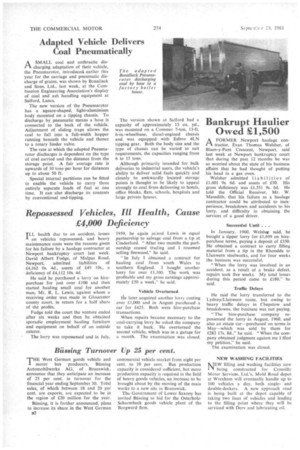Adapted Vehicle Delivers Coal Pneumatically
Page 36

If you've noticed an error in this article please click here to report it so we can fix it.
ASMALL coal and anthracite discharging adaptation of their vehicle. the Pneumarotor, introduced earlier this year for the carriage and pneumatic discharge of grains, was shown by Bonallack and Sons, Ltd., last week, at the Combustion Engineering Association's display of coal and ash handling equipment at Salford, Lancs.
The new version of the Pneumarotor has a square-shaped, light-aluminium body mounted on a tipping chassis. To discharge by pneumatic means a hose is connected to the back of the vehicle. Adjustment of sliding traps allows the coal to fall into a full-width hopper running beneath the vehicle and thence to a rotary feeder valve.
The rate at which the adapted Pneumarotor discharges is dependent on the type of coal carried and the distance from the storage point. A fair average rate is upwards of 10 tons per hour for distances up to about 50 ft.
Special internal partitions can be fitted to enable the vehicle to carry three entirely separate loads of fuel at one time. It can also discharge its contents by conventional end-tipping. The version shown at Salford had a capacity of approximately 13 cu. yd., was mounted on a Commer 7-ton, 13-ft. 6-in.-wheelbase, diesel-engined chassis and was equipped with Edbro 4LN tipping gear. Both the body size and the type of chassis can be varied to suit requirements, the capacities ranging from 6 to 15 tons.
Although primarily intended for bulk deliveries to industrial users, the vehicle's ability to deliver solid fuels quickly and cleanly to awkwardly located storage points is thought to be likely to appeal strongly to coal firms delivering to hotels, office blocks, flats, schools, hospitals and large private houses.




















































































































